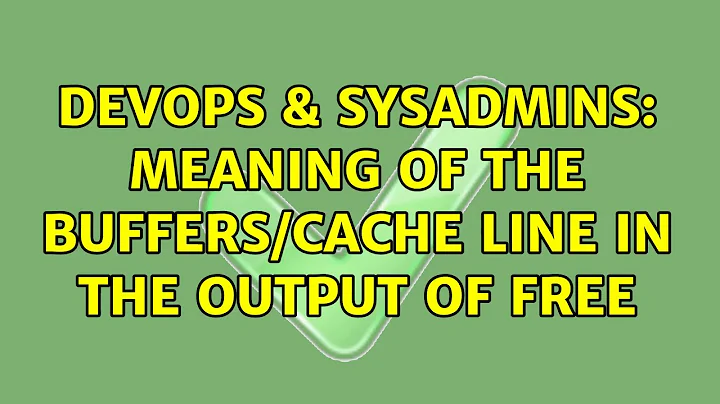Meaning of the buffers/cache line in the output of free
Solution 1
Meaning of the values
The first line means:
-
total: Your total (physical) RAM (excluding a small bit that the kernel permanently reserves for itself at startup); that's why it shows ca. 11.7 GiB , and not 12 GiB, which you probably have. -
used: memory in use by the OS. -
free: memory not in use. -
shared/buffers/cached: This shows memory usage for specific purposes, these values are included in the value forused.
The second line gives first line values adjusted. It gives the original value for used minus the sum buffers+cached and the original value for free plus the sum buffers+cached, hence its title. These new values are often more meaningful than those of first line.
The last line (Swap:) gives information about swap space usage (i.e. memory contents that have been temporarily moved to disk).
Background
To actually understand what the numbers mean, you need a bit of background about the virtual memory (VM) subsystem in Linux. Just a short version: Linux (like most modern OS) will always try to use free RAM for caching stuff, so Mem: free will almost always be very low. Therefore the line -/+ buffers/cache: is shown, because it shows how much memory is free when ignoring caches; caches will be freed automatically if memory gets scarce, so they do not really matter.
A Linux system is really low on memory if the free value in -/+ buffers/cache: line gets low.
For more details about the meaning of the numbers, see e.g. the questions:
- In Linux, what is the difference between "buffers" and "cache" reported by the free command?
- Why does Red Hat Linux report less free memory on the system than is actually available?
Changes in procps 3.3.10
Note that the output of free was changed in procps 3.3.10 (released in 2014). The columns reported are now "total", "used", "free", "shared", "buff/cache", "available", and the meanings of some of the values changed, mainly to better account for the Linux kernel's slab cache.
See Debian Bug report #565518 for the motivation, and What do the changes in free output from 14.04 to 16.04 mean? for more details information.
Solution 2
The currently accepted answer from 2009 is out-of-date. It is important to make sure that the information you are getting is correct and matches the version of free (distributed in the Debian package procps or equivalent in your distribution). It is also helpful to look at the output of man free, and also man 5 proc, which contains information about /proc/meminfo, the file where free gets its data from on Linux.
By default, free's output is in kibibytes (1 kibibyte = 1024 bytes), as you can see in the manual page. I prefer to use the -h argument, which shows suffixes, like this:
$ free -h
total used free shared buff/cache available
Mem: 15Gi 6.1Gi 1.9Gi 301Mi 7.5Gi 8.8Gi
Swap: 979Mi 0B 979Mi
The first line Mem means:
-
total(Mem): total installed memory (that isMemTotalfrom/proc/meminfo), this all the memory in RAM -
used(Mem): used memory, equal tototal - free - buffers - cache -
free(Mem): unused memory (that isMemFree), this all the memory that is unused for anything (even caches) in RAM -
shared(Mem): this is the amount of memory used mainly fortmpfs(Shmem) -
buff/cache(Mem), sum ofbuffersandcache:-
buffers: memory used by kernel buffers (Buffers), which is memory that the kernel can take advantage of -
cache: memory used by the page cache and slabs (CachedandSReclaimable). The page cache contains the contents of files in the filesystem cached to RAM, and it is generally a good thing for this to be a high number. I presume "slabs" are a similar caching feature.
-
-
available(Mem): this is an estimate of how much memory is available for starting new applications, without swapping. It includes most of memory counted in thecachefield (since the page cache can be dropped to start new applications), but it does not count swap (since it is generally preferable not to use slow swap space).
The second line is Swap. This is my explanation:
-
total(Swap): this is the total amount of disk space reserved for swap (SwapTotalinproc/meminfo). You can check by checking that this matches with the output ofswapon -s. -
used(Swap): the amount of swap disk space that is currently being used. Again, you can check this by comparing it with the output ofswapon -s -
free(Swap): the amount of swap disk space that is currently not being used (SwapFreein/proc/meminfo). It is equal tototal (Swap) - used (Swap)
Solution 3
The buffers/cache line shows you how much memory is used by programs (first of those columns), and is free for programs to use (second column). It's a fairly esoteric number, and not something you'd really look at much in practice.
Related videos on Youtube
Muahmmad Zeeshan
Updated on September 17, 2022Comments
-
Muahmmad Zeeshan over 1 year
Why does my server show
total used free shared buffers cached Mem: 12286456 11715372 571084 0 81912 6545228 -/+ buffers/cache: 5088232 7198224 Swap: 24571408 54528 24516880I have no idea on calculating the memory in linux. I think it says that 5088232 is used where as 7198224 is free, meaning it is actually consuming 5GB of RAM?
-
 Kyle Brandt over 14 years
Kyle Brandt over 14 years -
aaaser about 12 yearsFor anyone needing an even more simple, step-by-step explanation, check thoughtsbyclayg.blogspot.com/2008/09/…, his explanation helped me a lot.
-
 Sasha over 8 years
Sasha over 8 years -
Rick O'Shea almost 4 yearsThis is flat out incorrect. The buff/cache is definitely NOT part of used. I'm just looking at a box with 1G used and 12G buff/cache. unix.stackexchange.com/questions/521488/…
-
-
Muahmmad Zeeshan over 14 yearsAnd what does the first line (mem line) means
-
 womble over 14 yearsThat you've got 12GB of RAM installed in the system, 11.5GB of which is used and 0.5GB or so is currently unused. Approximately 82MB of the used memory is used for buffers (network connections, etc), whilst about 6.5GB is being used to store copies of data on disk, so that data won't have to be re-read if it's needed again.
womble over 14 yearsThat you've got 12GB of RAM installed in the system, 11.5GB of which is used and 0.5GB or so is currently unused. Approximately 82MB of the used memory is used for buffers (network connections, etc), whilst about 6.5GB is being used to store copies of data on disk, so that data won't have to be re-read if it's needed again. -
Muahmmad Zeeshan over 14 yearsLet me just summarize what i understood. server have 12GB of ram installed. off which first line shows 11.5GB is used. 82MB is free. Second line shows 4.8GB is used by programs. and 6.86GB is being used to copy disk data (second row second column). Now it all means that the system has reached its limits and we have to install more memory?
-
pauska over 14 yearsNo, you do not need to install more memory, unless you are experiencing very high i/o disk throughput. Having files in cache instead of being accessed from disk is a good thing.
-
sleske over 14 years@Muhammad: "82MB is free." - no, 57MiB is free (but that doesn't really matter, see my answer). "Now it all means that the system has reached its limits" - No, not at all. The system has 6.9GiB in use for caching, which it will readily give to applications, so there's lots of room. Also, swap usage is very low (ony ca. 50MiB). If memory starts getting tight, swap usage will rise. At present you're barely using half the RAM you have.
-
Muahmmad Zeeshan over 14 yearsIn this case if our processes/programs increases the value in 2nd row ist column will increase as more processes will consume more memory and the value in 2nd row 2nd column will decrease because the memory for new processes will be allocated from here and our disk I/O will also increase.
-
 womble over 14 yearsNot necessarily. Past a certain point the cache hit rate doesn't increase from adding more memory. Linux will use whatever memory is available for disk cache, it doesn't just use what it really needs. If you're worried about your disk IO rates, you should monitor those directly, not try to infer something from loosely related information.
womble over 14 yearsNot necessarily. Past a certain point the cache hit rate doesn't increase from adding more memory. Linux will use whatever memory is available for disk cache, it doesn't just use what it really needs. If you're worried about your disk IO rates, you should monitor those directly, not try to infer something from loosely related information. -
Muahmmad Zeeshan over 14 yearshow can i monitor I/O
-
 womble over 14 yearssar -d 1 0 {pad}
womble over 14 yearssar -d 1 0 {pad} -
Muahmmad Zeeshan over 14 yearshow can i explicitly allocate resources to a particular side. e.g. Network
-
 womble over 14 yearsHave you considered asking a new question at some point?
womble over 14 yearsHave you considered asking a new question at some point? -
 Aaron Hudon almost 9 yearsI disagree, the buffers/cache line is the actual free memory of the system and therefore most relevant if you want to know if the system has room for programs.
Aaron Hudon almost 9 yearsI disagree, the buffers/cache line is the actual free memory of the system and therefore most relevant if you want to know if the system has room for programs. -
CMCDragonkai almost 9 yearsCould you expand on what kinds of things Linux may be caching? Would it be files that have been accessed or network stuff?
-
sleske almost 9 years@CMCDragonkai: The answer to serverfault.com/questions/23433/… addresses in detail what constitues "cache" and "buffer".
-
 SCBuergel about 7 yearsI do not think the statement "total = used + free" is correct, see the following output on my machine:
SCBuergel about 7 yearsI do not think the statement "total = used + free" is correct, see the following output on my machine:$ free -htotal used free shared buff/cache availableMem: 3.4G 585M 152M 11M 2.6G 2.5GSwap: 4.0G 84M 3.9G -
sleske about 7 years@Sebastian: Ah, interesting. It seems the ouput of free was changed (in 3.3.10). I edited my answer to mention this. If you are interested in this change, consider asking a new question :-).
-
Melroy van den Berg over 5 yearsThe 'free' is indeed not literally free, it is perfectly fine to have 'free' close to zero. Since the "Free" RAM is used for disk cache under Linux. And no, it will not decrease your RAM available size, since if more RAM is needed on your system, the disk cache will be automatically decreased if needed.
-
Melroy van den Berg over 5 years
total = used + free + buff/cache -
Tobitor over 3 yearsThanks for that answer! One question from my side: If I would like to look if a server will run out of memor, should I then use the number of
free Memor should I also consider the number regardingbuffer+cache? -
Don Foumare over 3 years@Flimm At least in Ubuntu 18 and 20
totalis justMemTotal(withoutSwapTotal). Why wouldtotalfrom the first line (Mem) includeSwapTotaleven though it's beeing explicitly listed in the line below (Swap)? -
Flimm over 3 years@DonFoumare By "Ubuntu 18", do you mean Ubuntu 18.04 or Ubuntu 18.10? Likewise, by "Ubuntu 20", do you mean Ubuntu 20.04 or Ubuntu 20.10? Any way, I think you're right, after looking at
map freeandman 5 proc. I've edited my answer. -
Flimm over 3 years@DonFoumare This is why I love contributing to ServerFault! Any misunderstandings I have get corrected for free! :)
-
Don Foumare over 3 years@Flimm I meant Ubuntu 18.04 and 20.04




